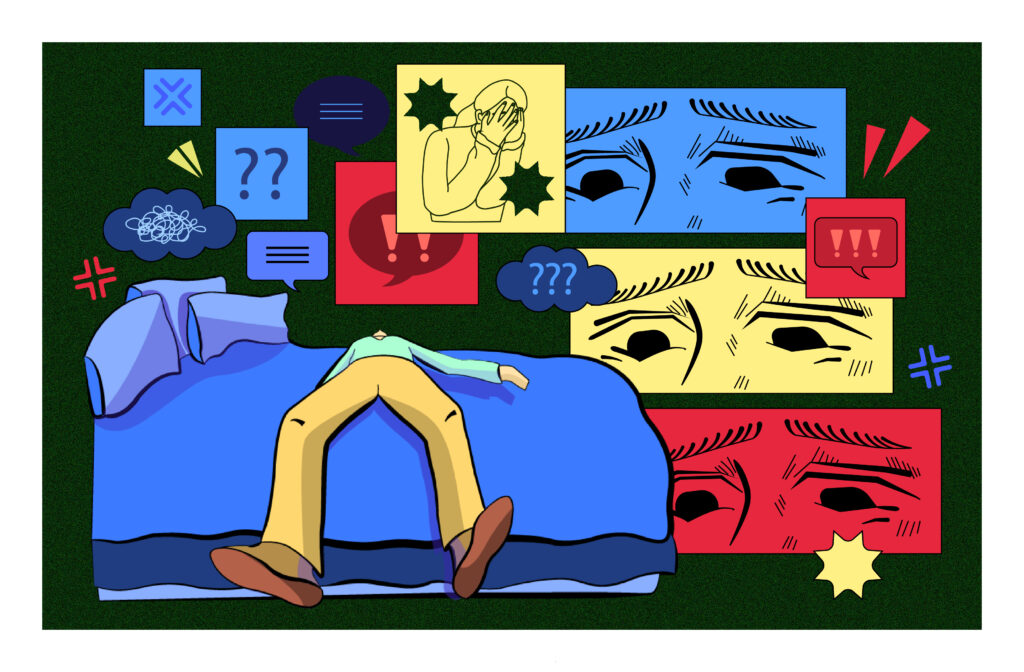This piece contains detailed discussions of Obsessive-Compulsive Disorder (OCD), including descriptions of intrusive thoughts, compulsions, and rituals that may be distressing to some readers. If you are sensitive to content about mental health conditions, particularly OCD, or if you find such topics triggering, please proceed with caution.
When I first came across Emma Noyes promoting her new book How to Hide in Plain Sight on TikTok, I knew that I had to read it. I had been following Noyes for her content on OCD awareness and her own experience with the disorder for about a year. Her posts were a necessary reminder that I was not alone. I hadn’t even known that she was a writer which made her words all the more meaningful to me, especially since my OCD had attacked my own writing for so long. Having lived with undiagnosed OCD for 10-plus years, I’ve developed somewhat of a thing for other people with OCD and their stories. For years, my compulsions went unnamed. My obsessions went undiagnosed. My urges unrecognized for what they truly were. I thought the constant, distressing and impulsive thoughts were my secret to contend with. Until one day a simple Google search told me that they weren’t.
Most media showcases OCD as a quirky obsession with germs and cleanliness, and while contamination OCD does exist, it’s a much smaller subset of OCD themes than you might think. There are a number of sub-types that make up OCD but the PSYCH 101 version is this: There are two parts to the disorder: obsessions and compulsions. Pretty obvious from the name, right? Obsessions are a bit easier to spot: unwanted and recurring thoughts or images that cause intense anxiety. These obsessions are often brought on by intrusive thoughts or images. There is a stark contrast between intrusive thoughts and impulsive thoughts; although, Tik Tok trends would make you believe otherwise. For example, intrusive thoughts are demanding thoughts and images that take over: “Plan a murder-suicide for your entire family!” or “Have sex with your dog!” Impulsive thoughts are more along the lines of “Dye your hair blonde today!” or “Get extra fries from McDonald’s!” The content is a bit different. Intrusive thoughts are ego-dystonic, meaning they don’t align with a person’s self-image or values and often lead to intense anxiety. Impulsive thoughts are the opposite. You can take them or leave them, but they aren’t in direct opposition to who you are the way that intrusive thoughts are.
For me, OCD long-meant constant intrusive thoughts about self-harm, sex, and wondering for hours in a day if something I’d said five years ago meant I was secretly a bad person. In moments of stress or anxiety or any free time, really, I would go over these thoughts again and again, trying to make sense of them and, at the same time, preventing myself from acting on them. This is called rumination, which is a compulsion, but because it is not visible like counting objects, tapping, or washing your hands, it is almost impossible for the outside world to spot. So most of us with OCD are left suffering in silence, not knowing that everything we’re experiencing is OCD.
Emma Noyes’s How to Hide In Plain Sight follows Eliot Beck who returns home to her family’s private island in Canada for her brother’s wedding. For the past three years, Eliot has been running from her family and her OCD, avoiding contact with anyone from home and throwing herself into her work in New York. But when she comes back to Cradle Island and is forced to spend a weekend with her family and previous best friend/love of her life, Manuel, Eliot is forced to reconcile with the ways she’s hurt the people she loves. She learns that avoiding things may not be the answer to her problems at all.
Noyes’s main character, Eliot, is immediately familiar to anyone with OCD. From her textbook-like obsessions with relationships, her sexuality, and her morality, to the more complicated and less obvious obsessions like the ones about her memories of her dead brother Henry, Eliot is relatable.
In addition to providing a very real account of what it’s like to live with OCD, Noyes explores the different ways in which the disorder can attack a person’s relationships, both familial and romantic. At the heart of it, How to Hide In Plain Sight is a love story, something I never thought would be possible for me. For so long, I didn’t think I deserved it. I spent my middle school years pining over boys—well, more like obsessing over one boy, every thought and interaction consumed by hours of endless analysis. He felt like a character I conjured up, creating a persona, drafting dialogue and staging action scenes.You know when you repeat a word so many times that it loses its meaning? You look at it and you know how it sounds and what it means, but it doesn’t really make sense anymore. You’ve been thinking about it too hard for too long until, like bubblegum you’ve chewed too much, it’s no longer soft, but hard and stuck in your teeth. You can no longer make sense of it. For almost 10 years, I did this with almost all of my thoughts. Again and again and again. If you’re confused, you should be. It’s overwhelming as hell.
In high school and college, it got even worse. For every positive thought I considered, I went over the bad ones a thousand times more until I was convinced they were more likely to happen than the good. That’s what OCD does to you—it convinces you that every horrible scenario you’ve imagined is not just possible, but probable, for no reason other than the fact that you thought it. I was terrified that I would do something stupid or I would blurt out a slur or I’d act on some impulse I’d long stashed away. So instead, I did nothing.

Needless to say, I never got a teenage love story. Like present-day Eliot, I avoided sex and romantic relationships at all costs, terrified of the intrusive thoughts they would trigger. I didn’t drink until I was 22 (and in treatment for my OCD) for fear of spilling every “secret” my OCD had convinced me I had. I was terrified of lowering my inhibitions, the same way Eliot had when she described one of her first experiences drinking alcohol with Manuel.
After returning to the island and spending time with Manuel during her family’s tradition of the Cradle Olympics, Eliot starts to panic. Noyes writes, “Ever since that night, I’d done everything I could to repress sexual impulses within myself—even the ones I didn’t see as problematic . . . I shut it off.” All it took was a nudge and Eliot was off, thoughts spiraling out of control, just as she’d feared. I understand that. All it takes is one thing and suddenly, I’ve vanished, lost in the vortex of my own thoughts.
When it came to the thoughts Eliot couldn’t even put into words, the reason she had avoided Manuel all those years, when it came to that night— I felt, more than knew, what she was talking about. The worst types of OCD—the ones that even now, I can still barely speak about in therapy or write about in my journals. That, until recently, I couldn’t even put into words. There are many taboo themes that play a role in one’s OCD, including harm, sexual orientation, and incest, but Noyes choses to give her main character one of the worst.
Pedophilia OCD is a subset of OCD characterized by intrusive thoughts about children, usually in an aggressive or sexual manner. People living with POCD are so terrified of their thoughts, they usually avoid children altogether, compulsively checking and rechecking their bodies and thoughts to make sure that they don’t actually want to harm a child. The compulsion to check or ruminate brings temporary moments of relief, followed only by more nasty reflections, “What if?” and the cycle starts all over again.
Because of the taboo nature of this theme, POCD often goes undiagnosed for years, leading to long bouts of silent suffering. After Eliot has her first intrusive thought about a child at her graduation party, she thinks what so many of us do—that the only options are to kill yourself – or even worse to someone with OCD (at least in my experience), going to authorities because then other people would discover “who you really are.” Telling any sort of authority is part of the reason that OCD can go undiagnosed for so long – you’d rather die than tell anyone. Which is why OCD awareness is actually suicide prevention.
Noyes writes from the mindset of someone with POCD best when she says, “My only choice is to live in limbo. To fear the worst in myself and never tell a soul.” So Eliot moves to New York, throws herself into her work and tries to keep herself so busy that she’ll forget what she’s trying to forget in the first place.
As someone with OCD, I commend Noyes for the honesty in her novel, especially when it comes to the more taboo themes like POCD. For most of us with OCD, we’ve spent our entire lives hiding in plain sight, just as her book title says. Performing quiet and internal compulsions that no one can see—that for a long time, we didn’t even know were compulsions. I couldn’t even believe at first that they were compulsions—that I had OCD. It was nothing like what the OCD I knew from the media—this wasn’t about handwashing or concerns about getting sick. This was something I thought was wrong with me, entirely my fault, my burden to bear. Only to one day learn that it had a name and millions of other people endure this too.For the past year, I’ve been trying to write a memoir about my own experience with OCD and have been reading as many different books on OCD that I can. I want to share with others what it’s like to be obsessed with the question of your sexuality for so long that you compulsively avoid it for years. Noyes’s book has begun to help me reconcile with my disorder and the trauma and despair it has brought me. I want to do that for someone else. I want this to be a journey that helps me discover that OCD is only a small part of a bigger story—maybe even a love story. I want to tell the world about my two halves. I want to write a new narrative about OCD. Noyes’s How to Hide in Plain Sight has helped me get started on that journey. Right now, it’s nothing more than ramblings in my journals and random memories and thoughts in a Google Doc. Nothing is coherent yet, but it’s getting there. But for the first time in my life, I feel like I finally have the words to write the story I need to tell. It’s time to bring my secrets out of hiding.•




